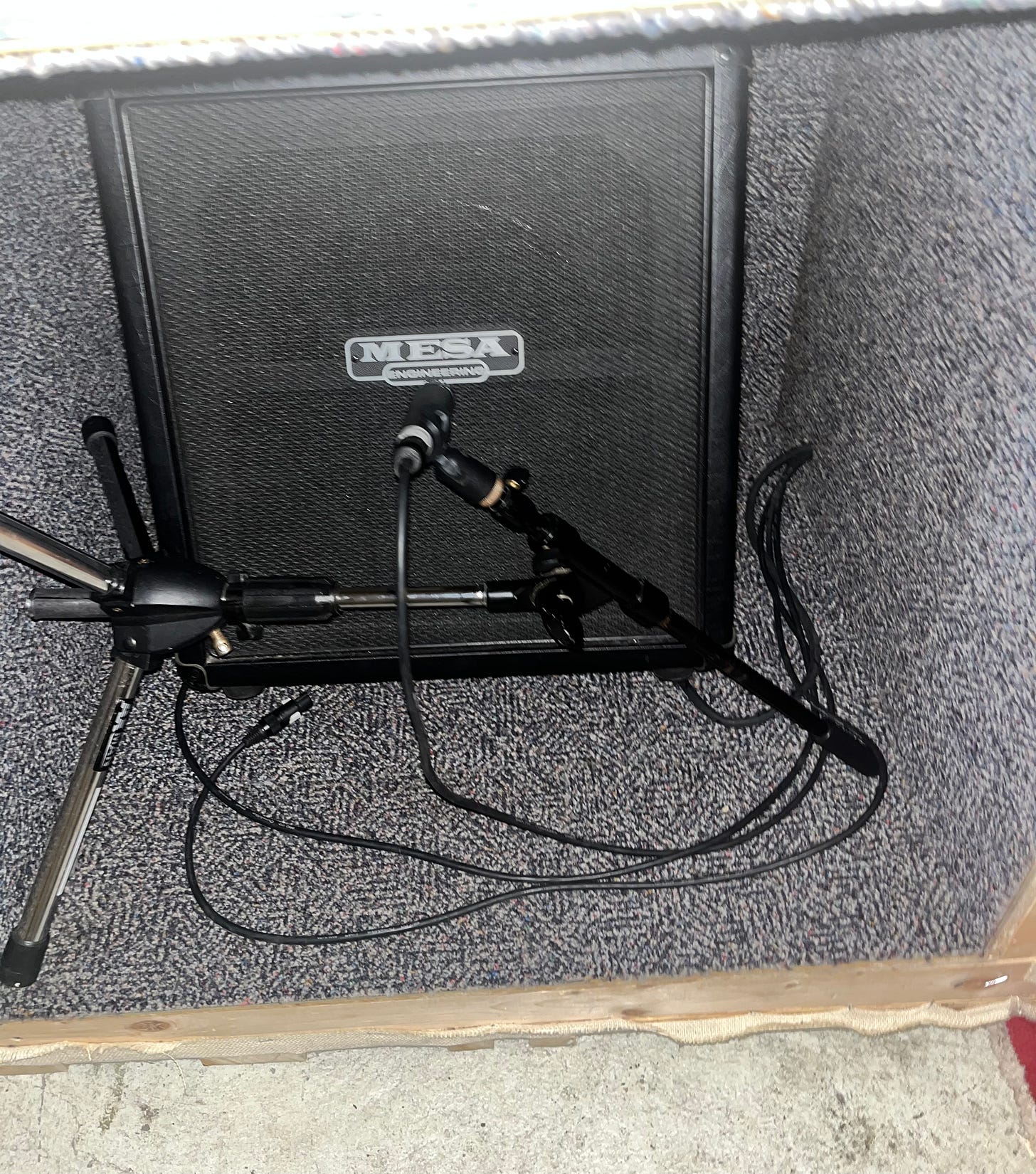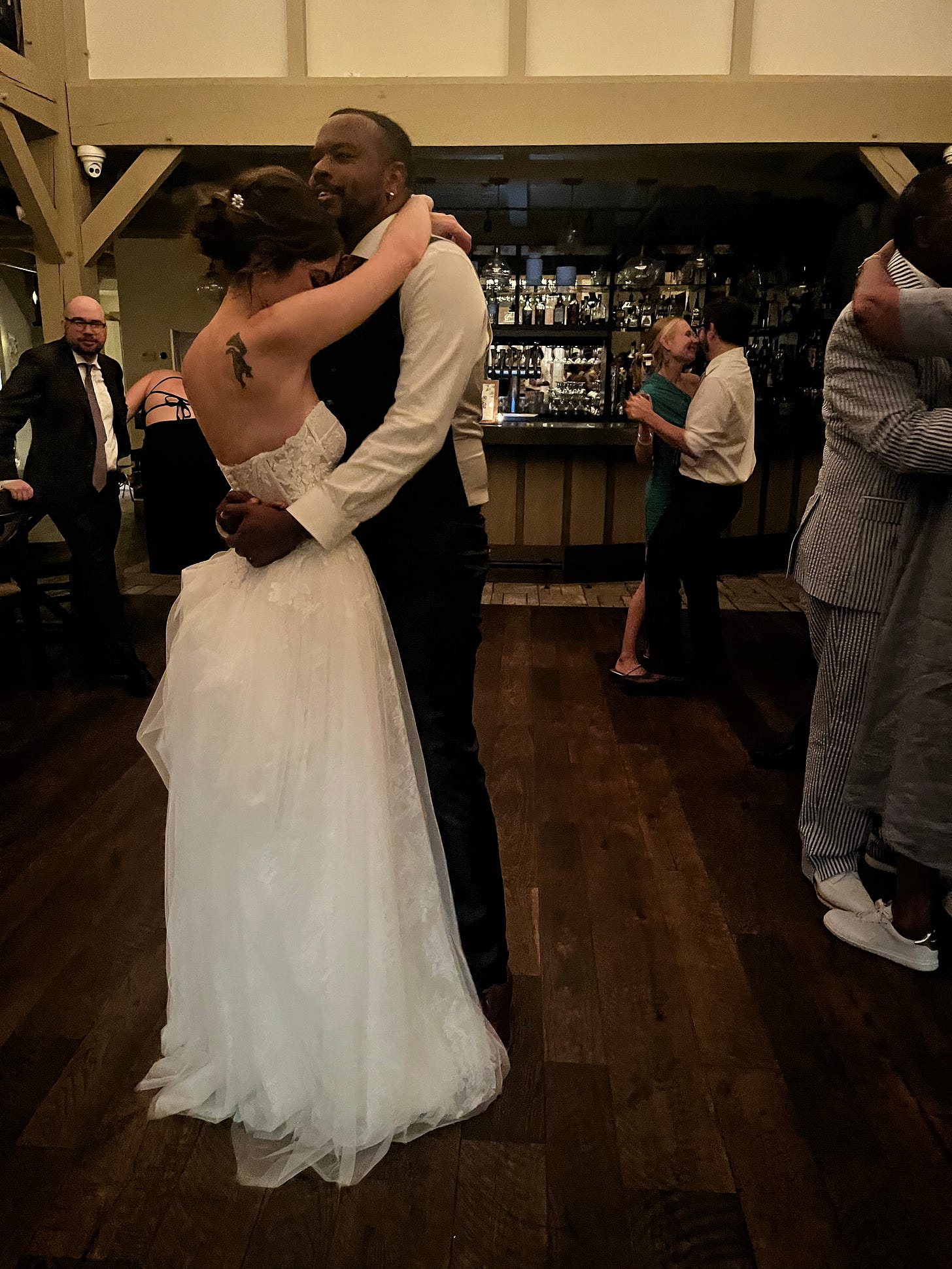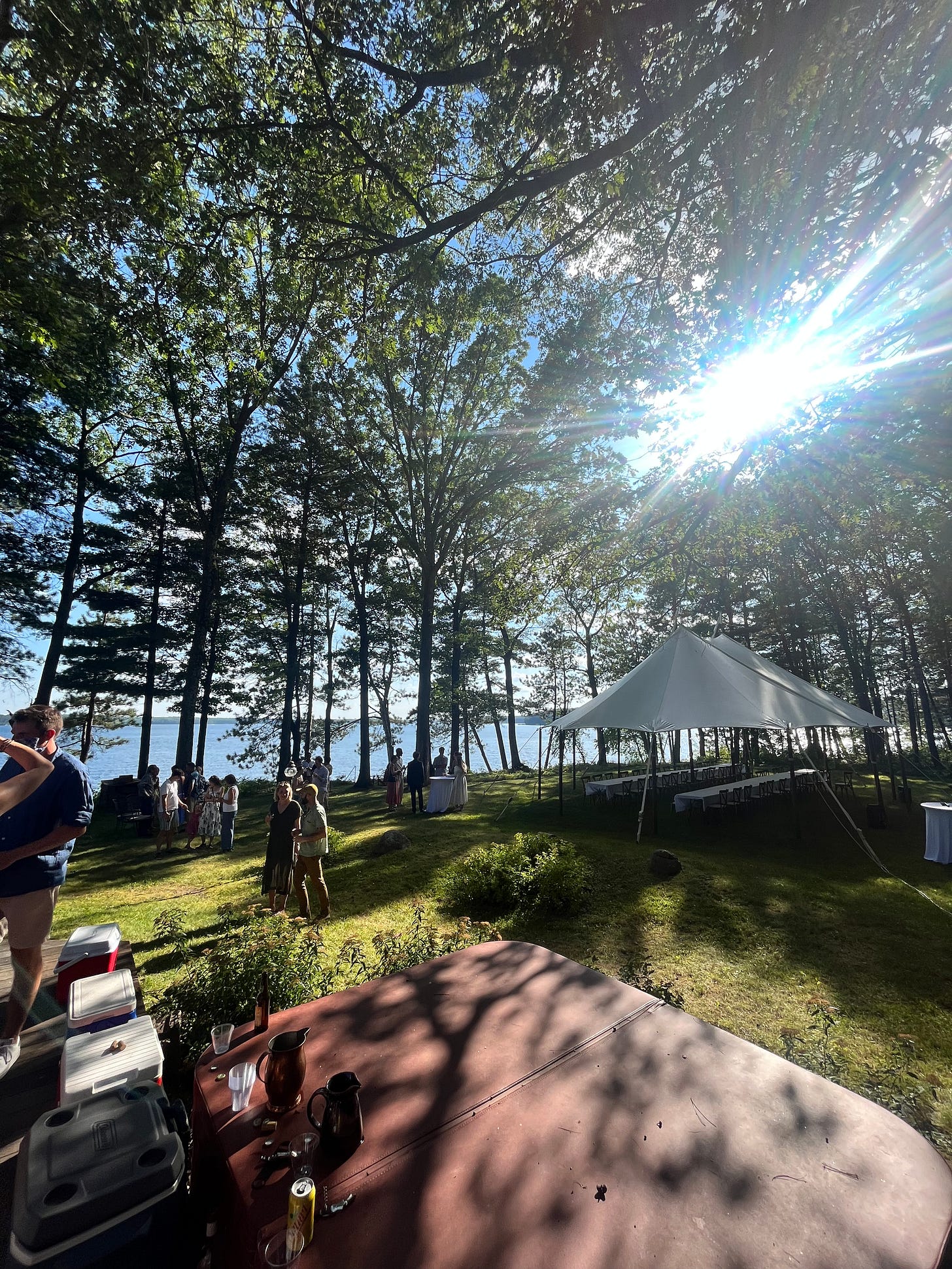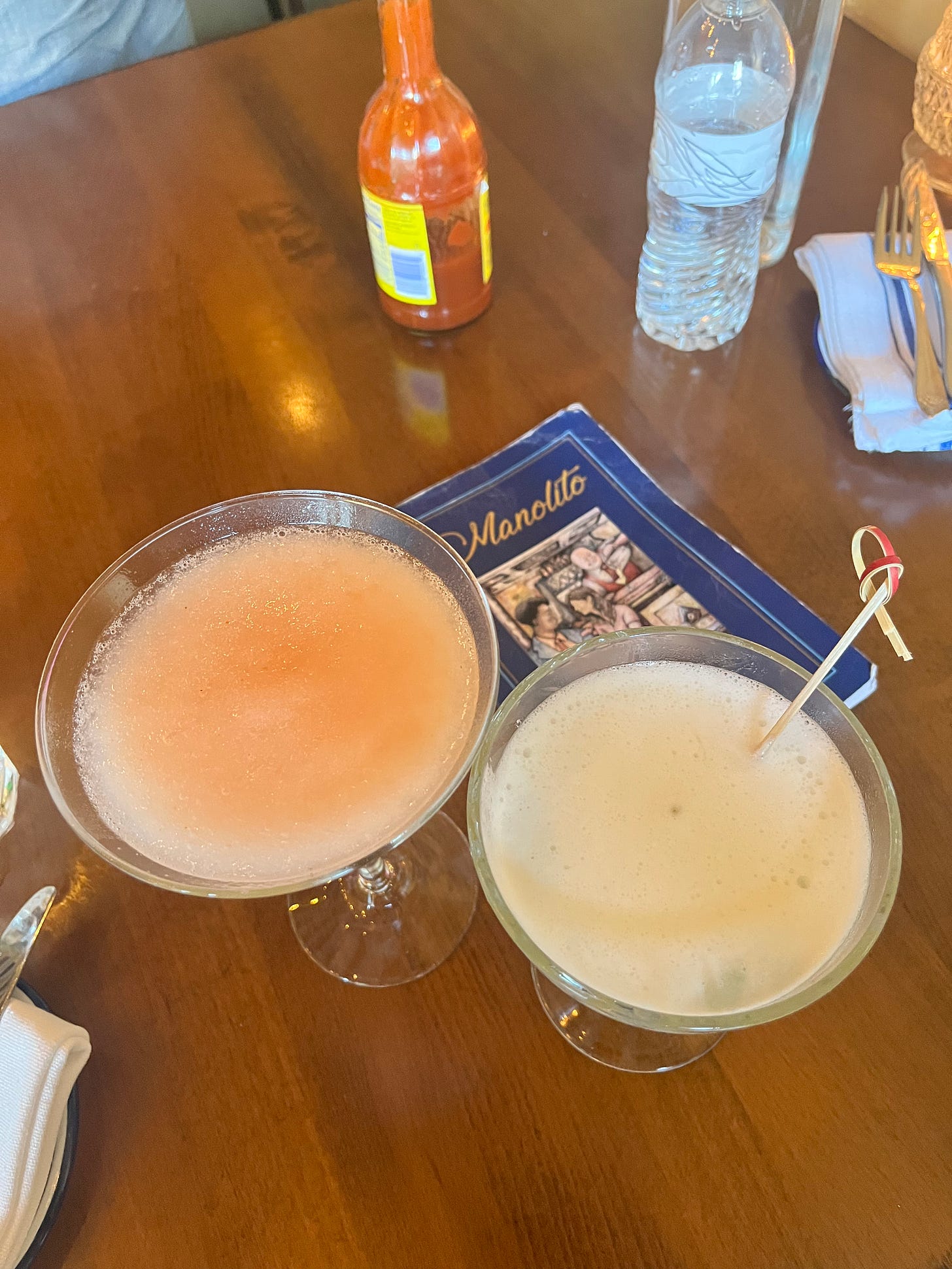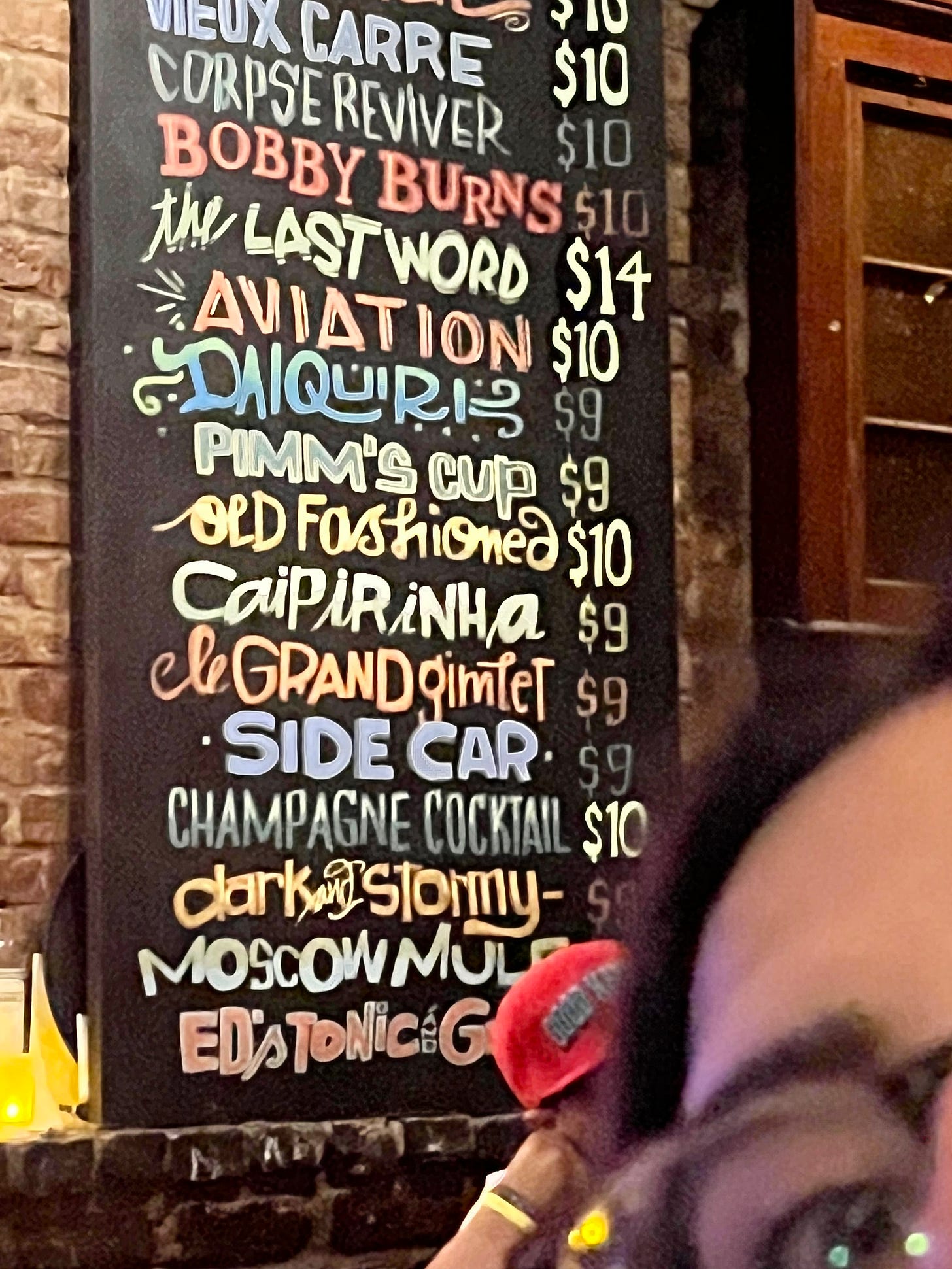A late summer of weddings and recordings
Dispatches from my first two weddings, Kela's drum tracking session and the show that has re-inspired love for the bass, killer cocktails in New Orleans, and a killer reading list.
What I’m Thinking
It’s been a while since I’ve posted. I’ve been busy. Too busy, really, to carve out time to write. In the past two months, I’ve gone to two weddings, took a brief trip to New Orleans, and did a two-day recording session for my band, Kela. Most other weeks I’ve worked 6 days a week.
Since the recording sessions back in August, I’ve spent much of my free time scheming guitar and bass parts for my songs. In the live iteration of Kela, I play guitar and sing and for most of Kela’s existence, I’ve focused my efforts on improving my guitar playing and guitar tones. But when we laid down drum trucks at Greenpoint Recording Collective, I realized I’d have to do something different for this session.
Many bands like to record and capture a live performance ala Steve Albini. I find that method noble, but doing that for Kela would make it impossible for this record to reflect what I hear in my head. In this session, I played guitar and sang (softly) the parts that Adam, our drummer, needed to hear to get a good take. By the third or fourth take of each song, I usually dumbed down my guitar parts to their most essential elements — no frills and no flourish, only what Adam needed to get his parts right.

Adam’s performance during our two days of recording was unbelievable. In just two days, we knocked out 10 songs. Two of those songs Adam barely knew. One of those songs I thought I might play on the drums. But after I recorded a solid, albeit, rudimentary drum take, Adam got behind the kit and distilled the essence of what I did into something far more potent and dynamic.
On day one, we knocked out the songs that give us the least trouble live and whose structures are the most stable. We saved day two for the songs that were new-ish to Adam and for the songs that would demand the most of him physically. Somehow, Adam breezed through the hard stuff, including one song that goes from a propulsive tom build-up into a jackhammering blast beat that falls apart into a wall of noise. For that song, I really had to dumb down my scratch guitar part to provide some stability.
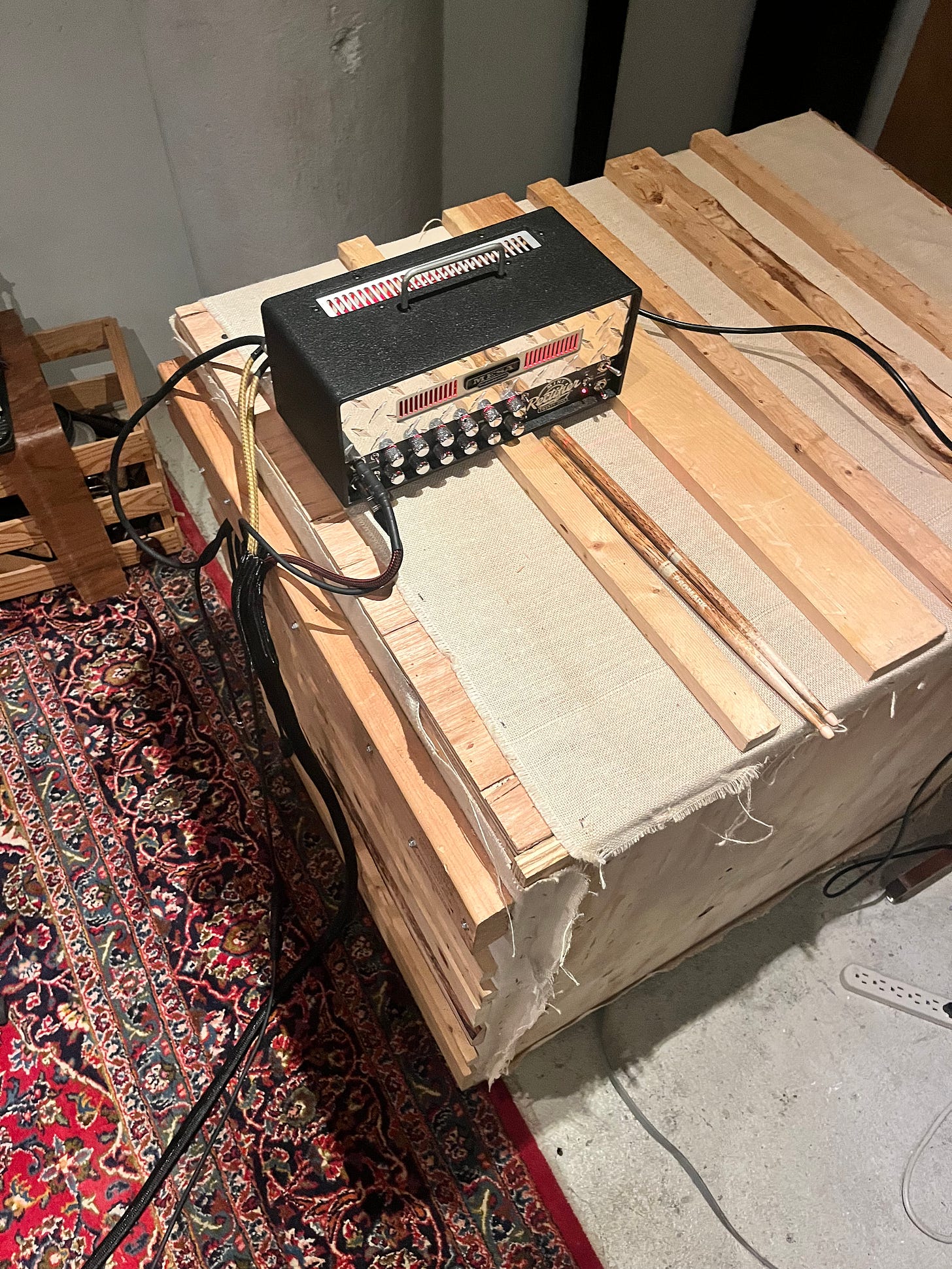
Those simplified guitar parts from our sessions at Greenpoint Recording Collective will not be on this record. Instead, I’ll track all the guitars at home, and later on, Tommy and I will re-amp them in a big room. What I like about this process — artificial as it may seem — is that I can experiment without the financial and time constraints of recording in a proper studio. When we finally make it to whatever studio or big room we’ll use for the re-amping, all the parts will be ready to go and nobody will be pressed about not having enough time to try something weird.
As Tommy, my bass player/eternal collaborator/roommate/producer, tinkers with Adam’s drum tracks, I must wait to record my parts. That’s ok with me. This recording process marks the third time in 7 years that Tommy and I have tried to record a Kela record, so what’s a little more waiting? While I wait, I’ve been playing a lot of bass to my songs.
In the other band I play with, Marinara, I play bass and I mostly recreate the parts of my dear friend, Julius Bowditch, because the parts he wrote are so devoted to these songs’ essence that changing them would be a spiritual faux pas. Otherwise, it’s been about a decade since I’ve played the bass in a songwriting context. I’m a much better musician than I was in 2014 or whenever I last wrote bass parts and I’m really enjoying playing bass through my headphone rig. Now, I can hear the details of every note and I give a lot of consideration to how hard or how soft I play individual notes or whether I pick a note with my right hand closer to the neck or closer to the bridge or if I should pull off with my left hand or pick with my right hand an individual note.
My recent love affair with the bass was also spurred by a recent concert I attended. Two weeks after our drum recording session, I saw my childhood favorite band, Jane’s Addiction, in a small venue. I’ve seen Jane’s a few times. The quality of their performances is inconsistent but this most recent show was special. In previous iterations of the Jane’s, the original bass player, Eric Avery, did not join. More recently their guitar player, Dave Navarro, sat out of two tours recovering from long COVID while Avery was back in the fold. But now the four of them are back together and in a small venue, I got close enough to see and truly feel the power of Eric Avery’s bass lines.
Most memorable Jane’s songs begin with Eric. In a song like Summertime Rolls, the bass line does not change for the duration of the song, and yet, the band floats and crests and soars over one simple bass line.
You might know their song, Mountain Song. It’s a two-part song built on a thundering bass line in the verses and an aggressive, strummed chord section in the chorus.
And then there’s Three Days, the band’s magnum opus. This song was recorded in one take with all the band members in the room, which was remarkable because tensions ran so high during the recording process that the band members recorded their parts for every other song separately.
Seeing those songs live and up close and watching Eric stomp around the stage was inspiring. The most impressive of Jane’s songs need Eric’s bass to ground them and I think I needed to see a bass-heavy band to guide me in my own recording process. The impatient part of me would have loved to start recording the guitar and bass parts for this Kela record as soon as possible, but in retrospect, everything worked out perfectly.
The Weddings
It would be rude of me to mention the two weddings of my dear friends and not talk about them or share some photos, so here we go.
My college friends, Malcolm and Mia, got married in late July at a lovely venue in Rawley, Massachusetts. This wedding was the first one I’ve attended as an adult and it included many friends from college and our extended social group. A large group of us rented an AirBnB about a half-hour from the venue. The home where we stayed had a pool table downstairs and three TVs, all of which our friend Danny turned to different Olympic competitions.
On the day of the ceremony, most of us alternated between getting pretty and playing pool. By some act of god, the weather for this late-July outdoor ceremony was mild and sunny. I sat in the back of the ceremony and when I saw Malcolm begin his walk down the aisle with his parents on either arm, I noticed the streak of a lone tear down his cheek. That got me and most of our other friends to start crying and for the duration of the ceremony, which was officiated with humor and grace by one of Mia and Malcolm’s close friends, most of us were in tears.
The dinner and dance portion of the night felt like a wholesome college reunion with everyone dressed to the 9’s. I’ve provided some photos below of the festivities, which were only dampened by a rusted and blown tire to one of our cars and ended in a AAA tow-truck experience after the wedding.


The very next weekend, my girlfriend and I flew to Minnesota and rode in a rental car with our friends, Nic and Bailie, to Hayward, Wisconsin for the wedding of our other college friends, John David and Tale. After a two-hour drive, we checked into a small-town lodge that was a temporary home to the many tourists visiting Hayward on this exact weekend to attend the Lumberjack World Championship. The night before the wedding, a school bus — I’m not kidding — picked up wedding attendees from the lodge and ushered us to the lake house wedding venue for a welcome BBQ.
In a curious twist of fate, a co-worker of mine was in Hayward only a few weeks before the wedding and he told me to look for a Wisconsin beer, Spotted Cow, that just so happened to be served at this welcome BBQ. I rarely drink beer nowadays, but the Spotted Cow was glorious. Spotted Cow is only sold in Wisconsin due to the progressive, pro-labor policies of the worker-owned company, but I’d drink it any time of year and in pretty much any context because of its refreshing, citrusy, and full-bodied flavor
The next morning, my girlfriend and I got ready for the wedding. I haven’t done the whole suit-and-tie thing since prom and I was a little out of my element. It took me a while to steam my clothes and I botched the tying of the tie, which John David and Nic noticed with laughter as they stood by the altar before the start of the ceremony. John David and Tale’s ceremony overlooked the lake from the backyard of Tale’s family home in Hayward and to be there amongst the families of the bride and groom felt like an entry into a gentle, private world.
John David and Tale have lived in Norway for nearly four years now. Until the COVID-19 pandemic, they lived in the Upper East Side. During the worst of the pandemic, Tale pitched John David on the idea of moving to Norway where she had family and John David said yes, he would gladly move across the world and start his life over. This was, to put it mildly, quite a change for John David, and in the past four years, he’s become fluent in Norweigan — enough that his English is tinted with an accent — and worked himself up from working at a wine bar to taking a PhD job at an esteemed university in Trondheim.
Tale’s speech during the wedding dinner focused not just on her love for John David, but on the remarkable challenges he’s faced since moving to Norway and the remarkable achievements he’s made since. John David sat in stoic silence during this speech — I don’t understand how he didn’t break — and I think that might be my favorite moment of the entire weekend. This wedding was not just a celebration of love; Tale’s speech made it a celebration of John David and the man he became after moving to Norway to be with her and build a life together.
What I’m Reading
Since the Hamas attacks on Israel on October 7th of last year, the Israeli press has reported on failings and snafus by the IDF that institutional giants of the US and international press have largely ignored. Various Israeli publications have confirmed in interviews with IDF soldiers involved in the fighting on October 7th that some in the IDF opened fire on hostages as they tried to kill Hamas fighters. These actions are in line with “The Hannibal Directive”, an edict within the IDF to do whatever it takes to prevent Israeli hostages from being taken and whose definition is loose enough to give IDF soldiers the interpretative leeway to kill potential hostages if needed. That directive was reportedly followed on October 7th and this article by ABC News Australia cites several Israeli news organizations who reported on the application of the Hannibal Directive on October 7th. This is something worth reading and you’re unlikely to see CNN, The New York Times, or other similar American news org report on.
Once upon a time, buying Adobe Photoshop was as simple as... buying the program and any relevant updates for a one-time fee. Adobe has since embraced monthly subscription fees and now, the mouse company, Logitech, seems poised to do as well. You can imagine how shitty this will be for consumers.
Fighting Fire and Fascism in the American West
Climate change is an obvious culprit for the recent and seemingly unrelenting spate of wildfires on the West Coast. In rural, woodland regions, anti-government sentiment has led to significant backlash against the Bureau of Land Management. This article in Dissent Magazine explores the potential for radicalization amongst the anti-BLM crowd and their increasingly fascist sentiments towards big government.
If you haven’t tired of articles with headlines like these, they are still worth reading.
Journal still can't confirm January story about UN agency for Palestinians
A few months back, the US and other major, first-world powers cut off funding to UNRWA, the United Nations Relief and Works Agency for Palestine, after The Wall Street Journal published an article alleging that scores of UNRWA workers were complicit in the deaths of Israelis on October 7th. WSJ’s sources for this article were Israeli and in the weeks and months after the article's publication, other new organizations could not confirm the allegations of the WSJ’s Israeli sources. Israeli sources lying to news organizations is hardly a surprise, but what is shocking is that the WSJ had internal doubts about their source’s truthfulness, per Semafor’s article that I’ve linked to,
I Tried Medium-Rare Chicken. You Should, Too.
As a late-in-life convert to an omnivore diet, there is lot I’m still learning about how meat is prepared. I didn’t, for example, know that raw chicken contained salmonella and only learned this when my dad barked at me to wash a cutting board where I’d cut chicken and was about to chop vegetables on. I know now that raw chicken is bad. But as I’ve started dabbling 9in the world of sushi and tartare and things of that (raw) nature), I’ve found myself wondering... is it possible... to eat raw chicken? This Slate article details one person’s attempt to eat the forbidden meat (fruit) and if this article is to be believed and proper food safety practices are adhered to, the forbidden meat tastes quite good.
Ed Zitron is a tech journalist whose work I’ve admired, in part because he confirms my pre-existing biases about AI and the profit-seeking of big tech companies that comes at the expense of said companies’ products.. I have no qualms about admitting my biases, which is why it brings me great pleasure to highlight Zitron’s recent article, which speculates that several prominent AI companies need access to an unprecedented amount of funding to stay solvent. Alhamdulillah!
Where Facebook's AI Slop Comes From
In recent years I’ve become an avid Facebook user, long after my similarly-aged peers abandoned it. Initially, I stayed on for Facebook marketplace and groups about musician gear. But in recent months, I’ve been fascinated by the mindless and bizarre AI-generated content on Facebook and I’m ashamed to say that this content has made a devoted Facebook user out of me. I even follow a Twitter account called, “Insane Facebook AI Slop,” which documents the most absurd of this content. I’ve often wondered, what compels someone to create such content. As it turns out, the answer is profit. 404 Media’s Jason Koebler did an impressive deep dive into the industry that generates AI slop and his findings are depressing. The short of it — Facebook has created profit incentives for clicks and likes that have led to a proliferation of AI-generated content from creators in Southeast Asia, India, and other adjacent areas where myths of posts that can fund a rickshaw have launched bizarre dreams of AI-generated wealth.
In the last two years, I rediscovered and grew very fond of Soundgarden’s music. I enjoyed their albums in passing in middle and high school but it didn’t truly click for me until I listened to Superunknown for a week straight as I drove around the high desert of Joshua Tree. Most people reading this are familiar with Soundgarden’s “Black Hole Sun” or “Spoonman”, but those two songs alone cannot possibly sum up the power of Chris Cornell and his larger-than-life voice. Welcome To Hell World’s recent Top 5 Song series on Chris Cornell highlights underappreciated Soundgarden songs as well as some of Cornell’s lesser-known works. This article is best appreciated with a pair of headphones on.
Families Flee NYC in Droves Over Child Care Costs, Affordability
Do you live in New York? Do you have family that often asks when you’re going to have kids? Are you tired of doing leftist rants about affordability, housing prices, and inflation to your family without hard data to back up your anecdotal experiences? If your answer is yes, this article will give you some solid, albeit depressing data points to defend an argument that having kids in New York City is a path to financial ruin.
The Giants are playing in Oakland for the last time, which is a travesty
The Athletic’s Grant Brisbee is one of this country’s greatest sportswriters and although he is a Giants fan, his take on the Giants’ final series in Oakland is a definitive one. For those of you who don’t keep up with sports: the Oakland Athletics’ selfish and filthy rich owner, John Fisher, decided he wanted to move the team to Las Vegas and plunder that municipality’s budget for a new stadium. For reasons I don’t fully understand, the city of Las Vegas thinks that Fisher, who has cut the A’s operating budget on and off the field down to the marrow, is operating in good faith and will try to field a competitive team in Vegas after not doing so in Oakland. The A’s are a legendary franchise and their quasi-rivalry with the Giants is explored with grace by Brisbee in this article.
Private security companies are a booming industry in the United States and these companies often consist of an army of poorly-trained and poorly-paid guards. This article’s author, Jasper Craven, spent six months working for a private security firm while writing this article and his insights are eye-opening. There’s the paranoid man who leads a training orientation and spends most of the orientation talking about potential terrorist threats while neglecting to teach trainees how to log visitors; there’s the “thin purple line” that guards now mark themselves with as they cosplay their belief that they too are a part of law enforcement; there’s the monotony and exhaustion that leads Craven and his co-workers to auto-pilot as they check ID’s of the many visitors that come to their building; there’s the piss-poor pay and constant turnover and so forth.
When I was a kid and the US was on the cusp of invading Iraq, I heard a lot about the war being a pretext for getting involved in Iraq’s oil industry. Years later, I read some books about the US invasion and life within the “Green Zone,” a haven that consisted of Saddam Hussein’s palace where US and coalition officials sequestered themselves from the entire rest of the country while making decisions about the entire rest of the country without consulting the entire rest of the country. Richard Beck’s article that I’ve linked to refreshed my memory on some of the absurdities of life in the Green Zone and it reminded me of the dogmatism of Paul Bremer, the US official who acted as the Iraqi head of state after the invasion. During his time as Iraqi head of state, Bremer dismantled a state economy that kept prices on basic goods low for Iraqis to liberalize their economy with little care for what it meant for everyday Iraqis while also holding seminars with young Iraqis to explain to them why this was a good thing. Enjoy!
What I’m Eating
The most notable meals I’ve had since my last post occurred in New Orleans. During my short trip there, I did not have beignet or crawfish or gumbo, but I was introduced to French cooking. What I’ll remember most vividly was the escargot my girlfriend and I ate at Antione’s in the French Quarter. The escargot was served in the sheet pan where it was baked and after spooning out the escargot, I dipped warm bread into the the pool of butter and parsley where the escargot was baked. All in all, a solid experience in which I learned that snail is just a vessel for butter.
Back in New York, a new bodega opened up across the block from me. Abu Ali is open 24 hours and their prices remind me of life before inflation. For $7 cash, I get their steak gyro, which is well seasoned with a generous serving of white sauce. It’s no Yasin, my preferred halal off of the Morgan L stop, but it’s solid and it’s cheap and 30 seconds from my apartment.
What I’m Drinking
Before going to New Orleans, I did some research on their bar scene and was thrilled to learn that the Big Easy is a daiquiri town. My girlfriend and I went twice to Manolito, a Cuban/Creole bar whose emphasis is on the daiquiri. Their multi-page menu had shaken daqs, frozen daqs, thrown daqs, double daqs, you name it. Our first round at Manolito was our best round — a frozen guava daiquiri and a Hotel Naciónal, a somewhat tart daiquiri that uses apricot liquor and pineapple juice.
Our friend Caro told us that her favorite bar in New Orleans, Tonique, was something we couldn’t miss. Caro was right. Tonique is a small dive bar on Rampart (one block away from the quarter where things are much calmer) with an extensive menu of quality cocktails for dirt-cheap prices. My eyes bulged when I saw that they served Trinidad Sours for just $14 bucks, so that’s all I ever ordered at Tonique.
A Trinidad Sour is, in my estimation, one of the most delicious cocktails ever made. It’s also very expensive to make, which is why you don’t see it on many menus. The Trinidad Sour typically consists of 1.5 ounces of angostura bitters and several other ingredients. Ango bitters usually run about $25 bucks for a 16-ounce bottle, so you’re looking at about $10 bucks of bitters before you do the math on the other ingredients. This is all to say, you won’t find a Trinidad Sour at many bars or find many bartenders willing to make one for you unless you’re willing to shell out.
But for whatever reason, Tonique had Trinidad Sours and for the first time in my life, I was able to have several of them in a night. What delight. The Trinidad Sour has a deep maroon color and its taste is as complex as the angostura bitters that the drink relies on. A good Trinidad Sour should have an almost spicy sweetness, notes of cinnamon and bark from the bitters, and a nice citrusy kick.
What I’m Doing
My mom and I are going to India in a few weeks to attend the NEEV Literature Festival and I’ll be sure to take as many photos as possible. My dad gets into New York right before I come back from India and while he’s in town, we’re going to see one his favorite bands, Soul Coughing. The breakup of Soul Coughing was ugly and the disdain between band members was potent enough that such a reunion seemed unlikely but here we are. Soul Coughing joins Jane’s Addiction and Oasis as bands with active reunions for whom this meme applies:
See ya!



